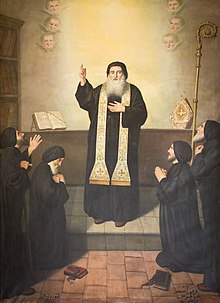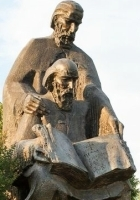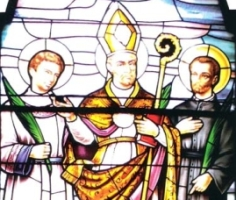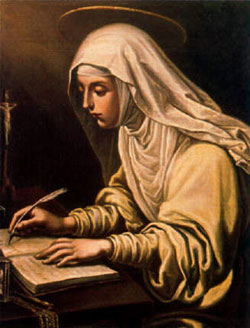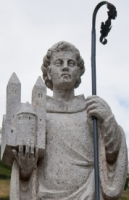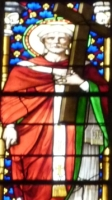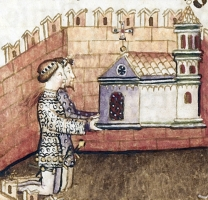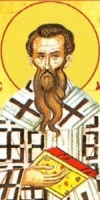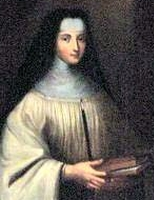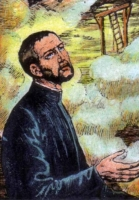St. Maro
Born Unknown
Syria Prima
(modern Syria)
Died 410 AD[1]
Kalota, Syria Prima
Venerated in Catholic Church (especially Maronite Church)
Eastern Orthodox Church
Feast February 14 (Eastern Orthodox Church)[2]
February 9 (Maronite Church)[3][4]
St. Maro chose a solitary abode not far from the city of Cyrrhus in Syria, and there in a spirit of mortification, he lived mainly in the open air. He had indeed a little hut covered with goatskins to shelter him in case of need, but he very seldom made use of it. Finding the ruins of the heathen temple, he dedicated it to the true God, and made it his house of prayer. St. John Chrysostom, who had a great regard for him, wrote to him from Cucusus, the place of his banishment, and, recommending himself to his prayers, begged to hear from him as often as possible. Maro was a disciple of St. Zebinus. He drew great crowds by his spiritual wisdom. He trained many hermits and monks and founded three monasteries. It is believed the Maronites take their name from Bait-Marun monastery near the source of the Orantes river, where a church was erected over his tomb. His feast day is February 14th.
"Maroun" redirects here. For other people with the name, see Maroun (name).
Maron, also called Maroun or Maro (Syriac: ܡܪܘܢ, Mārūn; Arabic: مارون; Latin: Maron; Greek: Μάρων), was a 4th-century Syrian[5] Syriac Christian hermit monk in the Taurus Mountains whose followers, after his death, founded a religious Christian movement that became known as the Syriac Maronite Church, in full communion with the Holy See and the Catholic Church.[6] The religious community which grew from this movement are the modern Maronites.
Saint Maron is often portrayed in a black monastic habit with a hanging stole, accompanied by a long crosier staffed by a globe surmounted with a cross. His feast day in the Maronite Church is February 9.
Life
Maron, born in what is now modern Syria, in the middle of the 4th century, was a priest who later became a hermit, retiring to the Taurus Mountains in the region of Cyrrhus, near Antioch. His holiness and miracles attracted many followers, and drew attention throughout the empire. John Chrysostom wrote to him around AD 405 expressing his great love and respect, and asking Maron to pray for him.[4] Maron and Chrysostom are believed to have studied together in the great Christian learning center at Antioch, which at the time was the third largest city in the Roman Empire.[3]
Maron embraced a life of quiet solitude in the mountains north-west of Aleppo.[7] He was known for his simplicity and his extraordinary desire to discover God's presence in all things.[3]
Maron is considered the Father of the spiritual and monastic movement now called the Maronite Church.[4]
Monastic spirituality
Maron's way was deeply monastic with emphasis on the spiritual and ascetic aspects of living. For Maron, all was connected to God and God was connected to all. He did not separate the physical and spiritual world and actually used the physical world to deepen his faith and spiritual experience with God.[4] He was able to free himself from the physical world by his passion and fervour for prayer and enter into a mystical relationship of love with God.
He lived his life in the open air next to a temple he had transformed to a church. He spent his time in prayer and meditation exposed to the forces of nature such as sun, rain, hail and snow. Theodoret of Cyrrhus wrote that this was a new type of asceticism that soon enjoyed wide acceptance in Syria and Lebanon. His Religious History, written around AD 440, mentions fifteen men and three women who followed this practice, many of them trained or guided by Maron.[7]
Missionary
Saint Maron was a mystic who started this new ascetic-spiritual method that attracted many people in Syria and Lebanon to become his disciples. Accompanying his deeply spiritual and ascetic life, he was a zealous missionary with a passion to spread the message of Christ by preaching it to all he met. He sought not only to cure the physical ailments that people suffered, but had a great quest for nurturing and healing the "lost souls" of both non-Christians and Christians of his time.
This missionary work came to fruition when in the mountains of Syria, Saint Maron was able to convert a temple into a Christian church in Kafr Nabu.[3][8] This was to be the beginning of the conversion to Christianity in Syria which would then influence and spread to Lebanon. After his death in the year 410 in Kalota,[9] his spirit and teachings lived on through his disciples.
His burial place is a debated issue. Some Lebanese sources, such as Giuseppe Simone Assemani and Maronite bishop Yusef al-Dibs believed he was buried in Arethusa or modern-day al-Rastan along the Orontes River in Syria, while others, like Jesuit priest Henri Lammens, have claimed he is buried in Brad village to the north of Aleppo.[10]
The Maronite movement reached Lebanon when Saint Maron's first disciple, Abraham of Cyrrhus, who was called the Apostle of Lebanon, realized that there were many non-Christians in Lebanon and so he set out to convert them to Christianity by introducing them to the way of Saint Maron.[7] William of Tyre, chronicling his arrival in the region of Lebanon during the crusades, writes of the Maronites that they took their name from a certain Maro, whose heresies (described as monothelitism) they followed for "almost five hundred years", but which they recanted at the time of William's report. Though William of Tyre's indictment of "Maro and his followers" as monothelite heretics has resulted in controversy among scholars, in all probability he was mistakenly referring to a Maro from Edessa instead of the fourth-century St. Maro.[11] Maronite historians argue that they have always remained in full communion with Rome.[12] Saint Maron's feast day is celebrated on February 9.[13]
Veneration
Saint Maron was known for his gift for healing.
Saint Cyril
புனிதர்கள் சிரில் மற்றும் மெதோடியஸ்
ஆயர்கள்/ ஒப்புரவாளர்கள் (Bishops/ Confessors)
அப்போஸ்தலர்களுக்கு நிகரானவர்கள் (Equals to the Apostles)
ஐரோப்பாவின் பாதுகாவலர்கள் (Patrons of Europe)
அடிமைகளின் அப்போஸ்தலர்கள் (Apostles to the Slavs)
பிறப்பு :
சிரில் : 826 அல்லது 827
மெதோடியஸ் : 815
தெசலோனிக்கா, பைஸான்தீனிய பேரரசு (தற்போதைய கிரேக்க நாடு)
இறப்பு :
சிரில் : ஃபெப்ரவரி 14, 869
ரோம் (Rome)
மெதோடியஸ் : ஏப்ரல் 6, 885
வெலெராட், மொராவியா
ஏற்கும் சமயம் :
ரோமன் கத்தோலிக்க திருச்சபை (Roman Catholic Church)
மரபுவழி திருச்சபை (Orthodox Church)
ஆங்கிலிக்கன் சமூகம் (Anglican Communion)
லூதரன் திருச்சபை (Lutheran Church)
பாதுகாவல் :
ரோமன் கத்தோலிக்க மற்றும் மரபுவழி திருச்சபைகளுக்கிடையேயான ஒற்றுமை
ஐரோப்பா (Europe),
பல்கேரியா (Bulgaria),
"மசெடோனியா" குடியரசு (Republic of Macedonia),
"செக்" குடியரசு (Czech Republic),
"ஸ்லோவேகியா" (Slovakia),
"ல்ஜூப்ல்ஜனா" உயர்மறை மாவட்டம்
புனிதர்கள் சிரில் மற்றும் மெதோடியஸ் ஆகிய இரு சகோதரர்களும் "பைஸன்டைன்" (Byzantine) நாட்டின் கிறிஸ்தவ இறையியலாளர்களும், மறை பரப்பாளர்களுமாவர். அவர்களின் நற்பணிகள் மூலம், அனைத்து அடிமைகளின் கலாச்சார வளர்ச்சியிலும் மேம்பாடு பெற்றனர். இதன் காரணமாகவே, இவர்களிருவரும், "அடிமைகளின்அப்போஸ்தலர்" என்று போற்றப்பட்டனர்.
தற்போதைய கிரேக்க நாடான "பைஸன்டைன்" (Byzantine) நாட்டில் பிறந்த இவர்களிருவரினதும் தந்தை பெயர் "லியோ" (Leo) ஆகும். "மரியா" (Maria) இவர்களது தாயார் ஆவார். லியோ மற்றும் மரியாவுக்கு பிறந்த ஏழு குழந்தைகளில் சிரில் கடைக்குட்டி ஆவார். சிரிலின் இயற்பெயர் "காண்ஸ்டன்டைன்" (Constantine) ஆகும். இவர் தமது மரணத்தின் சிறிது காலத்தின் முன்னே ரோம் நகரில் துறவறம் பெற்றபோது, சிரில் என்னும் மதப் பெயரை ஏற்றுக்கொண்டார்.
"மைக்கேல்" (Michael) எனும் இயற்பெயர் கொண்ட மெதோடியஸ், துருக்கி நாட்டின் வடமேற்கு பிராந்தியத்திலுள்ள "மைசியன் ஒலிம்பஸ்" (Mysian Olympus) என்னுமிடத்தில் துறவறம் பெற்றபோது, தமது மதப் பெயராக "மெதோடியஸ்" எனும் பெயரை ஏற்றுக்கொண்டார்.
சிரிலுக்கு பதினான்கு வயது நடக்கையில் அவர்களது தந்தையார் மரணமடைந்தார். அந்நிலையில், பேரரசின் முதலமைச்சர்களுள் ஒருவராயிருந்த "தியோக்டிஸ்டோஸ்" (Theoktistos) என்பவர் அவர்களின் பாதுகாவலரானார். அவரே அவர்களது கல்விக்கும் உதவி புரிந்தார். இவர்கள் இருவரும் சிறப்பான முறையில் கல்வியைப் பூர்த்தி செய்தனர். சிரில், தமக்கு கிடைத்த ஆளுநர் பதவியை புறக்கணித்தார். ஆனால் அதே வேளையில் அவரது சகோதரரான மெதோடியஸ் "ஸ்லாவிக்" (Slavic) மொழி பேசும் மக்கள் வசிக்கும் பிராந்தியத்தில் அப்பதவியை ஏற்றுக்கொண்டார்.
சிரில், ஒரு துறவு மடத்தில் இணைந்தார். அவரது சகோதரர் மெதோடியஸ், சிறிது காலம் அரசு பதவியில் பணியாற்றிய பிறகு துறவு மடத்தில் இணைந்தார்.
"மொராவியா" (Duke of Moravia) பிராந்திய பிரபு, கிழக்குப் பிராந்திய பேரரசன் மைக்கேலிடம் (Eastern Emperor Michael) ஜெர்மன் ஆட்சியாளர்களிடமிருந்து அரசியல் சுதந்திரமும் திருச்சபை சுயாட்சியும் (Ecclesiastical Autonomy) கேட்டபொழுது, சிரில் மற்றும் மெதோடியஸ் ஆகிய இருவரின் வாழ்வில் திட்டவட்டமான மாற்றம் உண்டாகியது. அவர்கள் மறைப் பணியை ஏற்றுக்கொண்டனர்.
சிரிலுடைய முதல் பணி, கிழக்கு விதிமுறைகள் அமலிலிருந்த அப்பிராந்தியத்தில் ஒரு புதிய எழுத்துக்களை கண்டுபிடித்தலாயிருந்தது. பின்னர், அவருடைய சீடர்கள் சிரில்லிக் எழுத்துக்களை (Cyrillic alphabet) உருவாக்கினர். அவர்கள் சுவிசேஷங்கள், துதிப்பாடல், பவுல் எழுதிய கடிதங்கள் மற்றும் வழிபாட்டு புத்தகங்கள் ஆகியனவற்றை இணைந்து "ஸ்லாவோனிக்" (Slavonic) மொழியில் மொழிமாற்றம் செய்தனர். ஸ்லாவோனிக் வழிபாட்டு முறையையும் உருவாக்கினர். மிகவும் சரளமாக அவர்கள் பிரசங்கித்த முறையானது, ஜெர்மன் மதத்தவரிடையே எதிர்ப்பை உருவாக்கித் தந்தது. அப்போதைய ஜெர்மன் ஆயர், ஸ்லாவிக் ஆயர்களையும் குருக்களையும் (Slavic bishops and priests) அருட்பொழிவு செய்ய மறுத்தார்.
இதன் காரணமாக சிரில் ரோமுக்கு மேல்முறையீடு செய்தார். ரோம் நகருக்கு பயணித்த சிரிலும், மெதோடியஸும் 'திருத்தந்தை இரண்டாம் அட்ரியான்' (Pope Adrian II) தமது புதிய கண்டுபிடிப்பான "சிரில்லிக் எழுத்துக்களை" (Cyrillic alphabet) அங்கீகரித்தது கண்டு அகமகிழ்ந்தனர். ரோம் நகரில் துறவறம் பூண்ட சிரில், நீண்ட காலம் வாழ இயலாமல் ஐம்பதே நாட்களில் மரணமடைந்தார்.
மெதோடியஸ் தமது மறை பணிகளை மேலும் பதினாறு வருடங்களுக்கு தொடர்ந்தார். அவர் ஸ்லாவிக் மக்களுக்கு திருத்தந்தையின் பிரதிநிதியாக செயல்பட்டார். புதிய ஆயர் ஒருவரை அருட்பொழிவு செய்தார்.
"பவேரியன் ஆயர்கள்" (Bavarian bishops) பலரது முன்னாள் அதிகார வரம்பிலிருந்த பகுதிகள் நீக்கப்பட்டதால், அவர்கள் மெதோடியஸுக்கு எதிராக பல குற்றச்சாட்டுப் புயலைக் கிளப்பினர். இதன் பயனாக, ஜெர்மன் பேரரசன் லூயிஸ் (Emperor Louis the German) மெதோடியசை மூன்று ஆண்டுகளுக்கு நாடு கடத்தினான். திருத்தந்தை எட்டாம் ஜான் (Pope John VIII) அவரை விடுவித்தார்.
ஃபிராங்கிஷ் (Frankish) மொழி பேசும் குருக்களின் தொடர்ந்த தொந்தரவு, வெந்த புண்ணில் வேல் பாய்ச்சியது போன்று இருந்தது. அவர்கள் தொடர்ந்து மெதோடியஸின் மேலே மதங்களுக்கு எதிரான குற்றச்சாட்டுக்களை சுமத்தினர். தம்மைக் காத்துக்கொள்ளவும், தமது கண்டுபிடிப்பான ஸ்லாவோனிக் வழிபாட்டு முறையின் பயன்பாட்டினை நிலைநிறுத்தவும், மெதோடியஸ் ரோம் நகர் பயணித்தார். மீண்டும் தம்மை அவர் நிரூபித்தார்.
அதன்பின்னர், மெதோடியஸ் ஜுர வேகத்தில், எட்டே மாத காலத்தில் மொத்த திருவிவிலியத்தையும் "ஸ்லாவோனிக்" (Slavonic) மொழியில் மொழிபெயர்த்தார். 885ம் ஆண்டின் தவக்காலமான ஏப்ரல் மாதம், புனித செவ்வாய்க்கிழமையன்று (6ம் தேதி), தமது தேவாலயத்திலேயே மெதோடியஸ் மரணமடைந்தார். அவர் மரிக்கும்போது அவரது சீடர்கள் அவரைச் சுற்றியிருந்தனர்.
மெதோடியஸின் மரணத்தின் பின்னரும் அவரது எதிர்ப்பாளர்கள் தொடர்ந்து எதிர்த்தே வந்தனர். சிரில் மற்றும் மெதோடியஸ் சகோதரர்களின் பணி "மொராவியா" (Moravia) நாட்டில் முடிவுக்கு வந்தது. அவர்களது சீடர்கள் சிதறிப்போயினர். ஆனால் இந்த வெளியேற்றங்கள் சிரில் - மெதோடியஸ் சகோதரர்களின் ஆன்மீக, வழிப்பாட்டு, மற்றும் கலாச்சார பணிகளை "பல்கேரியா", "போஹெமியா" மற்றும் "தென் போலந்து" (Bulgaria, Bohemia and Southern Poland) ஆகிய நாடுகளில் பரப்புவதில் சாதகமான விளைவைத் தந்தன. "மொராவியா" (Moravia) நாட்டின் பாதுகாவலர்களான இவர்கள் விசேடமாக, "செக்" மற்றும் ஸ்லோவாக்" கத்தொலிக்கராலும் (Catholic Czechs, Slovaks), "குரோஷியர்களாலும்" (Croatians), "செர்பிய" மற்றும் "பல்கேரிய" (Orthodox Serbians and Bulgarians) மரபுவழி திருச்சபையினராலும் புனிதராக ஏற்றுக்கொள்ளப்பட்டனர். சிரில் - மெதோடியஸ் சகோதரர்கள் நீண்ட கால விருப்பமான "கிழக்கு மற்றும் மேற்கு" திருச்சபைகளின் ஒன்றிப்பிற்காக சிறப்பாக பணியாற்றியிருந்தனர்.
1980ம் ஆண்டு, திருத்தந்தை இரண்டாம் ஜான் பால் (Pope John Paul II) இச்சகோதரர்களை ஐரோப்பிய நாடுகளின் (புனிதர் பெனடிக்டுடன்) இணை பாதுகாவலர்களாக நியமித்தார்.
Also known as
• Apostle of Bulgaria
• Apostle of the Slavs
• Apostle of the Southern Slavs
• Constantin
• Constantine the Philospher
• Constantine
• Cyril the Philosopher
• Equal of the Apostles
• Slavorum Apostoli
Additional Memorials
• 27 July as one of the Apostles of Bulgaria
• 6 April (Velehrd, Moravia)
Profile
Brother of Saint Methodius. Born to the Greek nobility; his family was connected with the senate of Thessalonica, and his mother Maria may have been Slavic. Studied at the University of Constantinople, and taught philosophy there. Deacon. Priest. Librarian at the church of Santa Sophia. Monk, taking the name Cyril. Sent with Methodius by the emperor in 861 to convert the Jewish Khazars of Russia, a mission that was successful, and which allowed him to learn the Khazar's language. In 863, sent with Methodius to convert Moravians in their native tongue. Though some western clergy opposed their efforts and refused to ordain their candidates for the priesthood, they did good work. Developed an alphabet for the Slavonic language that eventually became what is known today as the Cyrillic. After initial criticism for their use of it, the brothers achieved approval of the Liturgy in the Slavonic language. May have been bishop, but may have died before the consecration ceremony.
Born
827 at Thessalonica, Greece as Constantin
Died
14 February 869 at Rome, Italy of natural causes
Patronage
• against storms
• ecumenism
• Slavic peoples (given in 1863 by Pope Pius IX
• unity of the Eastern and Western Churches
• Bohemia
• Bosnia
• Bosnia-Herzegovina
• Bulgaria
• Carinthia, Austria
• Carniola
• Circassia
• Croatia
• Czech Republic
• Czechoslovakia
• Dacia
• Dalmatia
• Europe (given in 1980 by Pope John Paul II)
• Khazaria
• Krain
• Krajna
• Kranjska
• Moravia
• Pannonia
• Russia
• Silesia
• Slovenia
• Yugoslavia
• Ljubljana, Slovenia, archdiocese of
• Maribor, Slovenia, archdiocese of
• Saints Cyril and Methodius of Toronto, Ontario, diocese of
• Brno, Czechia, city of
Representation
• with Saint Methodius
• Oriental monk holding a church with the help of Methodius
• surrounded by Bulgarian converts
• wearing a long philosopher's coat
Saint Methodius
Also known as
• Apostle of Bulgaria
• Apostle of the Slavs
• Apostle of the Southern Slavs
• Equal of the Apostles
• Slavorum Apostoli
Additional Memorials
• 27 July as one of the Apostles of Bulgaria
• 6 April (Velehrd, Moravia)
Profile
Brother of Saint Cyril. Born to the Greek nobility. Studied at the University of Constantinople, and taught philosophy there. Priest. Sent with Cyril by the emperor in 861 to convert the Jewish Khazars of Russia, a mission that was successful, and which allowed him to learn the Khazar's language. In 863, he was sent with Cyril to convert Moravians in their native tongue. Though some western clergy opposed their efforts and refused to ordain their candidates for the priesthood, they did good work. Helped develop an alphabet for the Slavonic language that eventually became what is known as the Cyrillic today. After initial criticism for their use of it, they achieved approval of the Liturgy in the Slavonic language. Bishop. Evangelized in Moravia, Bohemia, Pannonia, and Poland. Baptized Saint Ludmilla and Duke Boriwoi. Archbishop of Velehred (in the modern Czech Republic), but deposed and imprisoned in 870 due to the opposition of German clergy with his work. Often in trouble over his use of Slavonic in liturgy, some claiming he preached heresy; repeatedly cleared of charges. Translated the Bible into the Slavonic languages. Pioneered the use of local and vernacular languages in liturgical settings.
Born
826 at Thessalonica, Greece
Died
6 April 885 at Moravia (modern Czech Republic)
Patronage
• against storms
• ecumenism
• Slavic peoples (given in 1863 by Pope Pius IX
• unity of the Eastern and Western Churches
• Bohemia
• Bosnia
• Bosnia-Herzegovina
• Bulgaria
• Carinthia, Austria
• Carniola
• Circassia
• Croatia
• Czech Republic
• Czechoslovakia
• Dacia
• Dalmatia
• Europe (given in 1980 by Pope John Paul II
• Khazaria
• Krain
• Krajna
• Kranjska
• Moravia
• Pannonia
• Russia
• Silesia
• Slovenia
• Yugoslavia
• Ljubljana, Slovenia, archdiocese of
• Maribor, Slovenia, archdiocese of
• Saints Cyril and Methodius of Toronto, Ontario, diocese of
• Brno, Czechia, city of
Representation
• with Saint Cyril
• Oriental bishop holding up a church with Saint Cyril
• Oriental bishop holding a picture of the Last Judgement
Saint Valentine of Rome
புனிதர் வேலண்டைன்
ஆயர் மற்றும் மறைசாட்சி:
பிறப்பு: கி.பி. 176
டேர்னி
இறப்பு: பிப்ரவரி 14, 273
ரோம்
ஏற்கும் சமயம்:
கத்தோலிக்க திருச்சபை
கிழக்கு மரபுவழி திருச்சபை
ஆங்கிலிக்கன் ஒன்றியம்
லூதரனியம்
நினைவுத் திருவிழா: பிப்ரவரி 14
சித்தரிக்கப்படும் வகை:
பறவைகள்; ரோஜா மலர்கள்; முடக்குவாதம் அல்லது வலிப்பு வந்த ஒரு குழந்தையோடு; ஆயரின் தலை வெட்டப்படுவது போல; வாள் ஏந்திய குருவாக; சூரியனோடு; குருடரை குணமாக்குவது போல
பாதுகாவல்:
திருமண உறுதி, மயக்கம், தேனீ வளர்ப்பு, திருமணம், காதல், கொள்ளைநோய், வலிப்பு நோய், முடக்குவாதம்.
புனிதர் வேலண்டைன் என்பவர், மூன்றாம் நூற்றாண்டின் பரவலாக அறியப்படும் ரோம புனிதர் ஆவார். உலகின் பல நாடுகளில் இவரின் விழா நாளான பிப்ரவரி 14ம் நாள், "வேலண்டைன் தினம்" என இவரின் பெயரால் அழைக்கப்பட்டு, காதலர்கள் மற்றும் காதலுக்கான நாளாகக் கொண்டாடப்படும் வழக்கம் நடுக்காலம் முதலே உண்டு.
இவரின் பெயர், மற்றும் இவர் ரோம் நகரின் வடக்கு பகுதியில் உள்ள ஃபிலாமினியாவில் பிப்ரவரி 14ம் நாளன்று கொல்லப்பட்டார் என்பதையும் தவிர இவரைப்பற்றிய வேறெந்த தகவல்களுக்கும் நம்பத்தகுந்த சான்றுகள் இல்லை.
புனிதர் வேலண்டைன் என்று ஒரு புனிதரா, அல்லது அதே பெயரில் இரு புனிதர்கள் உள்ளனரா என்பதும் உறுதியற்றதாக உள்ளது. இவரின் வரலாற்றை எழுதிய பலர் தரும் தகவல்கள் நம்ப முடியாததாகவும் பின்னர் சேர்க்கப்பட்டவைகளாகவும் இருக்கலாம்.
இந்த காரணங்களுக்காக இவரின் விழா நாள் 1969ல் திருத்தப்பட்ட உலகளாவிய கத்தோலிக்க திருச்சபையின் பொது நாள்காட்டியில் இடம்பெறவில்லை. ஆனாலும் "பிப்ரவரி 14 அன்று ஃபிலாமினியாவில் வழியாக மில்வியான் பாலத்திற்கு அருகில் கொல்லப்பட்ட மறைசாட்சி வாலெண்டினுஸ்" என்னும் பட்டத்தில் கத்தோலிக்க திருச்சபையினால் தனித்திருச்சபைகளின் வணக்கத்திற்காய் அதிகாரப்பூர்வமாக அங்கீகரிக்கப்பட்ட புனிதர்களில் பட்டியலில் இவரின் பெயர் உள்ளது.
Profile
Priest in Rome, possibly a bishop. Physician. Imprisoned for giving aid to martyrs in prison, and while there converted the jailer by restoring sight to the jailer's daughter. While Valentine of Terni and Valentine of Rome sometimes have separate entries in martyrologies and biographies, most scholars believe they are the same person.
There are several theories about the origin of Valentine's Day celebrations that relate to love and sentiment. Some believe the Romans had a mid-February custom where boys drew the names of girls in honour of the sex and fertility goddess, Februata Juno; pastors "baptised" this holiday, like some others, by substituting the names of saints such as Valentine to suppress the practice. Others maintain that the custom of sending Valentines on 14 February stems from the belief that birds begin to pair on that date; by 1477 the English associated lovers with the feast of Valentine because on that day "every bird chooses him a mate." The custom of men and women writing love letters to their Valentine started on this day. Other "romance" traditions have become attached to this feast, including pinning bay leaves to your pillow on Valentine's Eve so that you will see your future mate that night in your dreams.
Died
• beaten and beheaded c.269 at Rome, Italy
• buried on the Flaminian Way outside Rome
• relics later translated to the Church of Saint Praxedes
Patronage
• affianced, betrothed or engaged couples
• against epilepsy
• against fainting
• against plague
• apiarists, bee keepers
• greeting card manufacturers
• greetings
• happy marriages
• love
• lovers
• travellers
• young people
• Brendo, Italy
• Bussolengo, Italy
Representation
• birds
• roses
• bishop with a crippled or epileptic child at his feet
• bishop with a rooster nearby
• bishop performing a wedding
• bishop refusing to adore an idol
• bishop being beheaded
• priest bearing a sword
• priest holding a sun
• priest giving sight to a blind girl
Saint Juan García López-Rico
Also known as
• Giovanni Battista della Concezione
• Giovanni Garcia Xixon
• John Baptist de la Concepción Garcia
• Juan Bautista Rico
• Juan Bautista de la Concepción
• Juan García Gijón
• Juan García Xixón
• Juan Rico
Additional Memorial
15 February (diocese of Ciudad Real, Spain and diocese of Córdoba, Spain)
Profile
Fifth of eight children born to Xixón and Isabel García Marcos López-Rico; three of his siblings entered religious orders. As a child he was so drawn to follow the example of the saints that he nearly starved himself and endangered his health trying to live an ascetic life. At the age of 15 he met Saint Teresa of Avila which left him with a fascination with the Carmelites. He studied with the Carmelites in Almodóvar, Spain, and then at seminaries in Baeza and Toledo. Juan joined he Trinitarians on 28 June 1580, and made his profession on 29 June 1581. Ordained to the priesthood in 1585. On 20 August 1599 he received approval from Pope Clement VIII to begin a reformation of the Trinitarians; he based his efforts on the example of Saint Teresa of Avila and the original Rule of the Order which required six hours of prayer a day. In addition to reforming existing houses, he founded more monasteries that followed this new, invigorated form. Prolific writer on theology.
Born
10 July 1561 in Almodóvar del Campo, Ciudad Real, Spain
Died
14 February 1613 in Córdoba, Spain of nephritis
Canonized
25 May 1975 by Pope Paul VI
Saint Modestinus of Avellino
Also known as
• Modestinus of Mercogliano
• Modestin, Modestino
Additional Memorial
10 June (re-internment of relics)
Profile
Born to the nobility of Asia Minor. Bishop of Antioch, Turkey in 302, working with Saint Fiorentinus and Saint Flavianus. Imprisoned in the persecutions of Diocletian, he was miraculously freed and fled to Italy. There he was imprisoned for his faith in Locri, Italy by the local governor, but was released after he healed the governor‘s daughter through prayer; the governor and his family converted to Christianity. Evangelist in the area of Avellino, Italy, thought to have been led by Michael the Archangel to the places that most needed his preaching; reported to have convered 4,000 in one area. Imprisoned and martyred in persecutions of Maximian.
Born
c.245 in Antioch (modern Turkey)
Died
• burned to death by being wrapped in heated armor on 14 February 311 in Mercogliano, diocese of Avellino, Italy
• relics re-discovered 1166–1167 during a construction project led by Bishop William of Avellino
• relics re-interred in the crypt of the cathedral of Avellino on 10 June 1167
Canonized
• Pre-Congregation
• at the request of Bishop Francis of Avellino, in 1308 Pope Clement V granted an indulgence to those who made a pilgrimage to their shrine
Patronage
• Avellino, Italy, city of (given in 1220 by Ruggiero of Avellino)
• Avellino, Italy, diocese of (given in 1220 by Ruggiero of Avellino)
• Mercogliano, Italy
Saint Fiorentinus of Avellino
Also known as
• Fiorentinus of Mercogliano
• Fiorentino
Additional Memorial
10 June (re-internment of relics)
Profile
Priest in Antioch, Turkey, led by Saint Modestinus of Avellina. Imprisoned for his faith in the persecutions of Diocletian, he fled to Italy. There he was again imprisoned and martyred in persecutions of Maximian.
Died
• burned to death by being wrapped in heated armor on 15 February 311 in Mercogliano, diocese of Avellino, Italy
• relics re-discovered 1166–1167 during a construction project led by Bishop William of Avellino
• relics re-interred in the crypt of the cathedral of Avellino on 10 June 1167
Canonized
• Pre-Congregation
• at the request of Bishop Francis of Avellino, in 1308 Pope Clement V granted an indulgence to those who made a pilgrimage to their shrine
Patronage
• Avellino, Italy, city of (given in 1220 by Ruggiero of Avellino)
• Avellino, Italy, diocese of (given in 1220 by Ruggiero of Avellino)
• Mercogliano, Italy
Saint Flavianus of Avellino
Also known as
• Flavianus of Mercogliano
• Flaviano
Additional Memorial
10 June (re-internment of relics)
Profile
Deacon in Antioch, Turkey, serving Saint Modestinus of Avellina. Imprisoned for his faith in the persecutions of Diocletian, he fled to Italy. There he was again imprisoned and martyred in persecutions of Maximian.
Died
• burned to death by being wrapped in heated armor on 15 February 311 in Mercogliano, diocese of Avellino, Italy
• relics re-discovered 1166–1167 during a construction project led by Bishop William of Avellino
• relics re-interred in the crypt of the cathedral of Avellino on 10 June 1167
Canonized
• Pre-Congregation
• at the request of Bishop Francis of Avellino, in 1308 Pope Clement V granted an indulgence to those who made a pilgrimage to their shrine
Patronage
• Avellino, Italy, city of (given in 1220 by Ruggiero of Avellino)
• Avellino, Italy, diocese of (given in 1220 by Ruggiero of Avellino)
• Mercogliano, Italy
Saint Nostrianus of Naples
Also known as
Nostrian, Nostrien, Nostriano
Additional Memorial
16 August (discovery of relics; date set in 1619)
Profile
Fifteenth bishop of Naples, Italy, in the mid-5th century, serving for 17 years. Fought against the spread of the Arian, Manichean and Pelagian heresies in his diocese. Helped hold his people together and adhering to the faith during a period of barbarian invasion of the aging Roman empire, and helped support the civic life of the city of Naples. Gave refuge to Christians, including Saint Gaudiosus of Abitina and Saint Quodvultdeus of Carthage, who fled Carthage after it fell to the Vandals.
Died
• between 452 and 465 (records vary) of natural causes
• buried in the catacombs of San Gaudioso in Naples, Italy
• relics enshrined in the church of San Gennaro all'Olmo in Naples in the 10th century in a marble urn under the high altar
• relics re-discovered and re-enshrined on 16 August 1612
• relics re-enshrined in the church of Saints Philip and James in Naples in 1865
Canonized
2 May 1878 by Pope Leo XIII (cultus confirmation)
Blessed Vicente Vilar David
Profile
Youngest of eight children. Educated by the Piarists, and studied engineering in Valencia, Spain. Married to Isabel Rodes Reig, the main witness to his life and martyrdom, and who died in 1993. Spread a Christian outlook and morality among his peers, and known for charity to the poor. He worked as an industrial engineer in the family ceramics firm, and held several important municipal posts in which he put the Church's social teaching into practice. Always involved in parish activities and Catholic youth groups. Against the anti-religious sentiment of 1930's Spain, he worked to save persecuted priests and religious. As he was taken away to his martyrdom for supporting his faith, his wife said, "See you tomorrow!", and he answered, "Until tomorrow or in heaven!". Those who've studied his case believe he had a cause for canonization based solely on his life, not just his martyrdom.
Born
28 June 1889 at Manises, Valencia, Spain
Died
shot on 14 February 1937 in Manises, Valencia, Spain
Beatified
1 October 1995 by Pope John Paul II
Saint Derien of Brittany
Also known as
Derhen, Derchen, Derc'hen, Derrien
Profile
Seventh century knight from the British Isles. Pilgrim to the Holy Lands. Several churches in Brittany, France are named in his honour as he is considered one of the British who brought Christianity to the region.
Legend says that on his return from the Holy Lands, travelling with Néventer of Brittany, the two knights rescued Riok, the two-year-old son of the Count Élorn, from a dragon; Derien defeated the monster by making the Sign of the Cross over it, then using his sash as a leash to drag the animal to the English Channel at Pontusval, France where he ordered it to drown itself. Élorn refused to convert to Christianity, but offered them lands as a reward; they asked for just enough land to build a church.
As dragon slaying usually refers to killing off pagan practices or demonic worship, this legend may refer to Derien healing the nobleman’s child – there is a tradition in the area of asking for his intercession for sick children, and of a well, formerly dedicated to a pagan god but now dedicated to Derien, whose waters could be used to heal children.
Born
British Isles
Saint Valentine of Terni
Profile
Ordained by Saint Felician of Foligno. Consecrated bishop of Terni, Italy by Pope Victor I, c.197. Noted evangelist, miracle worker and healer, he was much loved by his flock. Imprisoned, tortured, and beheaded by order of the prefect Placid Furius during the persecution of Aurelius. He was murdered in secret and at night to avoid riots and revenge by the people of Terni. Some scholars believe that he and Saint Valentine of Rome are the same person.
Born
c.175 at Terni, Italy
Died
• on the Via Flaminia between Rome and Terni, Italy
• exhumed and re-interred outside the walls of Terni by his spiritual students
Patronage
• Altivole, Italy
• Luint, Ovaro, Italy
• Terni, Italy
• Terni-Narni-Amelia, Italy, diocese of
Saint Fortunata of Baucina
Also known as
Fortunata of Rome
Additional Memorial
2nd Sunday of September (patronal feast for the town of Baucina, Italy)
Profile
Young woman who converted to Christianity in her teens. Imprisoned for her faith by Imperial Roman troops, she was tortured and eventually executed when she refused to renounce Christianity. Martyr.
Born
c.182 in Palestrina, Rome, Italy
Died
• October 200 in Rome, Italy
• buried in the Saint Ciriaca catacombs of Rome
• relics transferred to Baucina, Italy on 29 January 1750; they arrived on 14 February 1750, and were enshrined in the church of the Collegio di Maria
• relics re-enshrined in an urn in 1840
Patronage
Baucina, Italy (declared on 9 April 1870 due to the level of devotion by local Christians)
Saint Auxentius of Bithynia
Profile
Career soldier and equestrian guard of Emperor Theodosius the Younger, he was known to preach to his fellow guards. He eventually left the service to become a hermit on Mount Oxia near Constantinople. Accused and cleared of Eutychianistic heresy. Archimandrite in Bithynia. Active in the Council of Chalcedon. Hermit on Mount Sinope (Skopas) near Chalcedon. Many were attracted to his austerity, holiness, counsel, and teaching; a community of nuns formed at Trichinarion near his mountain.
Born
at Syria
Died
14 February 473 at Mount Skopas of natural causes
Saint Abraham of Harran
Also known as
Abraames of Harran
Profile
Syrian hermit. Hoping to bring the faith to a village at Mount Lebanon, he set up shop as a fruit seller; the people were willing to buy his fruit, but abused him when he started to preach. He converted them by borrowing money to pay their taxes, which kept them out of prison, finally convincing them of the goodness of Christians. He worked to pay the debt, taught them for three years, found a priest to minister to them, then returned to solitude. Chosen bishop of Harran in Mesopotamia. Greatly influenced Theodosius the Younger, who carried that influence to the throne when he became emperor.
Died
c.422 of apparent natural causes at Constantinople while visiting the emperor
Saint Antoninus of Sorrento
Also known as
• Antoninus of Campagna
• Antoninus Cacciottolo
• Antoninus the Abbot
• Antonino...
Profile
Benedictine monk. Forced by war to leave his monastery, he was first a hermit, then abbot at Saint Agrippinus and teacher of the people of Sorrento, Italy.
Born
Campagna, Italy
Died
830 of natural causes
Patronage
• Campagna, Italy
• Sorrento, Italy
Representation
Benedictine monk holding a standard on a city wall
Saint Eleuchadius of Ravenna
Also known as
Eleucadio
Profile
Convert, brought to the faith by Saint Apollinaris of Ravenna who then ordained him a deacon. Bishop of Ravenna, Italy in 100; legend says he was chosen when a dove rested over his head, which was taken as a sign of the Holy Spirit descending on him.
Born
Greece
Died
• 14 February 112 of natural causes
• relics later enshrined in Pavia, Italy
Saint Alexandra of Egypt
Profile
To avoid the temptations of the world, around the age of 20 Alexandra walled herself up in a crypt in Alexandria, Egypt and spent 10 years as an anchoress, doing penance, praying, accepting meals through a slot in the wall, and giving spiritual advice to visitors.
Born
latter 4th century in Alexandria, Egypt
Died
late 4th century in Alexandria, Egypt of natural causes
Saint Louans of Chinon
Also known as
Lupance, Lupantius
Profile
Seventh century monk at the Abbey of Saint Mesmin near Orleans, France. Feeling a need for solitude with God, he retired to live as a hermit on the banks of the river Vienne near Chinon, France. Reported to have the gift of healing by prayer. A 12th century abbey dedicated to him was built on the site of his hermitage.
Saint Paulian of Le Puy
Also known as
Paolino, Pauliano, Paulien
Profile
Sixth century bishop of the Le Puy area of Gaul (modern Le Puy-en-Velay, France) based in the city of Ruessium (modern Saint-Paulien).
Saint Zeno of Rome
Also known as
Zenone
Profile
Martyr.
Died
• Rome, Italy
• in the cemetery of Praetextatus on the Appian Way outside Rome
Blessed Vincent of Siena
Profile
Franciscan friar, serving in the Order for 22 years. Travelled and worked with Saint Bernadine of Siena.
Died
1442
Blessed Antonia of Siena
Profile
15th century Franciscan tertiary who lived in the Santa Maria Nuova monastery in Ancona, Italy.
Born
Siena, Italy
Died
c.1455 of natural causes
Saint Felicula of Rome
Profile
Martyr.
Died
Rome, Italy
Saint Theodosius of Vaison
Profile
Bishop of Vaison, France.
Died
554
Saint Vitale of Spoleto
Profile
Martyr.
Died
Spoleto, Umbria, Italy
Saint Conran of Orkney
Profile
Bishop of the Orkney Islands, Scotland.
Saint Vitalis of Rome
Profile
Martyr.
Died
Rome, Italy
Martyrs of Terni
Profile
Three Christians who gave proper burial to Saint Valentine of Terni. Martyred in the persecutions of Aurelius. We know little more that their names - Apollonius, Ephebus, and Proculus
Died
273 in Terni, Italy
Twenty Mercedarians of Palermo
Profile
A group of twenty Mercedarians who, when an unspecified plague struck Palermo, Italy, volunteered to nurse the sick. They contracted the plague themselves, and died as martyrs of charity.
• Adriano Calabrò
• Andrea Schiafino
• Batilani Marsalio
• Bonaventura Palmerio
• Gaspare de Ortega
• Gaspare Fajolo
• Giovanni Battista de Sartis
• Giovanni Battista Mansa
• Giovanni Ruiz
• Giovanni Zorita
• Giuseppe Latona
• Michele de la Rosa
• Pietro Nolasco
• Pietro Salanitro
• Pietro Salino
• Stefano Marchesi
• Vincenzo Bonello
• Vincenzo Calderon
• Vincenzo Carrenzo
• Vincenzo Salanitro
Martyrs of Alexandria
Profile
A group of Christians murdered in various ways for their faith in Alexandria, Egypt. We know the names and a few details about 16 of them - Agatho, Agatone, Ammonio, Ammonius, Antonius, Bassiano, Bassianus, Cirione, Cyrio, Dionysius, Dionysius, Lucio, Moses, Moses, Proto, and Tonione.
Also celebrated but no entry yet
• Our Lady of Pellevoisin
• Our Lady of Bourbourg
• Elisabeth of Pomerania
• Valentine of Udine

